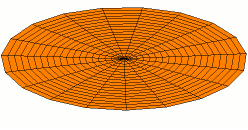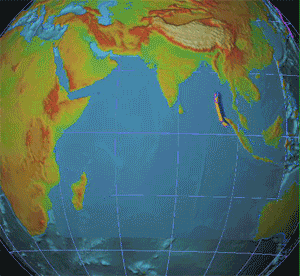|
Ground Vibrations
Ground vibrations is a technical term that is being used to describe mostly man-made vibrations of the ground, in contrast to natural vibrations of the Earth studied by seismology. For example, vibrations caused by explosions, construction works, railway and road transport, etc. - all belong to ground vibrations. General information Ground vibrations are associated with different types of elastic waves propagating through the ground. These are surface waves, mostly Rayleigh waves, and bulk longitudinal waves and transverse waves (or shear waves) propagating into the ground depth. Typical frequency range for environmental ground vibrations is 1 – 200 Hz. Waves of lower frequencies (below 1 Hz) are usually called microseisms, and they are normally associated with natural phenomenae, e.g. water waves in the oceans. Environmental ground vibrations generated by rail and road traffic may cause annoyance to residents of nearby buildings both directly and via generated struc ... [...More Info...] [...Related Items...] OR: [Wikipedia] [Google] [Baidu] |
Vibration
Vibration is a mechanical phenomenon whereby oscillations occur about an equilibrium point. The word comes from Latin ''vibrationem'' ("shaking, brandishing"). The oscillations may be periodic, such as the motion of a pendulum—or random, such as the movement of a tire on a gravel road. Vibration can be desirable: for example, the motion of a tuning fork, the reed in a woodwind instrument or harmonica, a mobile phone, or the cone of a loudspeaker. In many cases, however, vibration is undesirable, wasting energy and creating unwanted sound. For example, the vibrational motions of engines, electric motors, or any mechanical device in operation are typically unwanted. Such vibrations could be caused by imbalances in the rotating parts, uneven friction, or the meshing of gear teeth. Careful designs usually minimize unwanted vibrations. The studies of sound and vibration are closely related. Sound, or pressure waves, are generated by vibrating structures (e.g. vocal cords); ... [...More Info...] [...Related Items...] OR: [Wikipedia] [Google] [Baidu] |
Decibel
The decibel (symbol: dB) is a relative unit of measurement equal to one tenth of a bel (B). It expresses the ratio of two values of a power or root-power quantity on a logarithmic scale. Two signals whose levels differ by one decibel have a power ratio of 101/10 (approximately ) or root-power ratio of 10 (approximately ). The unit expresses a relative change or an absolute value. In the latter case, the numeric value expresses the ratio of a value to a fixed reference value; when used in this way, the unit symbol is often suffixed with letter codes that indicate the reference value. For example, for the reference value of 1 volt, a common suffix is " V" (e.g., "20 dBV"). Two principal types of scaling of the decibel are in common use. When expressing a power ratio, it is defined as ten times the logarithm in base 10. That is, a change in ''power'' by a factor of 10 corresponds to a 10 dB change in level. When expressing root-power quantities, a change in ''ampl ... [...More Info...] [...Related Items...] OR: [Wikipedia] [Google] [Baidu] |
Mechanical Vibrations
Mechanical may refer to: Machine * Machine (mechanical), a system of mechanisms that shape the actuator input to achieve a specific application of output forces and movement * Mechanical calculator, a device used to perform the basic operations of arithmetic * Mechanical energy, the sum of potential energy and kinetic energy * Mechanical system, a system that manages the power of forces and movements to accomplish a task * Mechanism (engineering), a portion of a mechanical device Other * Mechanical (character), one of several characters in Shakespeare's ''A Midsummer Night's Dream'' * A kind of typeface in the VOX-ATypI classification See also * Machine, especially in opposition to an electronic item * '' Mechanical Animals'', the third full-length studio release by Marilyn Manson * Manufactured or artificial, especially in opposition to a biological or natural component * Automation, using machine decisions and processing instead of human * Mechanization, using machine l ... [...More Info...] [...Related Items...] OR: [Wikipedia] [Google] [Baidu] |
Footnotes
A note is a string of text placed at the bottom of a page in a book or document or at the end of a chapter, volume, or the whole text. The note can provide an author's comments on the main text or citations of a reference work in support of the text. Footnotes are notes at the foot of the page while endnotes are collected under a separate heading at the end of a chapter, volume, or entire work. Unlike footnotes, endnotes have the advantage of not affecting the layout of the main text, but may cause inconvenience to readers who have to move back and forth between the main text and the endnotes. In some editions of the Bible, notes are placed in a narrow column in the middle of each page between two columns of biblical text. Numbering and symbols In English, a footnote or endnote is normally flagged by a superscripted number immediately following that portion of the text the note references, each such footnote being numbered sequentially. Occasionally, a number between bracke ... [...More Info...] [...Related Items...] OR: [Wikipedia] [Google] [Baidu] |
Shear Wave
__NOTOC__ In seismology and other areas involving elastic waves, S waves, secondary waves, or shear waves (sometimes called elastic S waves) are a type of elastic wave and are one of the two main types of elastic body waves, so named because they move through the body of an object, unlike surface waves. S waves are transverse waves, meaning that the direction of particle motion of a S wave is perpendicular to the direction of wave propagation, and the main restoring force comes from shear stress. Therefore, S waves cannot propagate in liquids with zero (or very low) viscosity; however, they may propagate in liquids with high viscosity. The name ''secondary wave'' comes from the fact that they are the second type of wave to be detected by an earthquake seismograph, after the compressional primary wave, or P wave, because S waves travel more slowly in solids. Unlike P waves, S waves cannot travel through the molten outer core of the Earth, and this causes a shadow zone for S ... [...More Info...] [...Related Items...] OR: [Wikipedia] [Google] [Baidu] |
Love Wave
In elastodynamics, Love waves, named after Augustus Edward Hough Love, are horizontally polarized surface waves. The Love wave is a result of the interference of many shear waves (S-waves) guided by an elastic layer, which is ''welded'' to an elastic half space on one side while bordering a vacuum on the other side. In seismology, Love waves (also known as Q waves (''Q''uer: German for lateral)) are surface seismic waves that cause horizontal shifting of the Earth during an earthquake. Augustus Edward Hough Love predicted the existence of Love waves mathematically in 1911. They form a distinct class, different from other types of seismic waves, such as P-waves and S-waves (both body waves), or Rayleigh waves (another type of surface wave). Love waves travel with a lower velocity than P- or S- waves, but faster than Rayleigh waves. These waves are observed only when there is a low velocity layer overlying a high velocity layer/ sub–layers. Description The particle motio ... [...More Info...] [...Related Items...] OR: [Wikipedia] [Google] [Baidu] |
Sonic Boom
A sonic boom is a sound associated with shock waves created when an object travels through the air faster than the speed of sound. Sonic booms generate enormous amounts of sound energy, sounding similar to an explosion or a thunderclap to the human ear. A decibel is the primary unit measurement of sound. "A thunderclap is incredibly loud, producing levels between 100 and 120 dBA ( decibels A)- the equivalent of standing near a jet during take-off." The crack of a supersonic bullet passing overhead or the crack of a bullwhip are examples of a sonic boom in miniature. Sonic booms due to large supersonic aircraft can be particularly loud and startling, tend to awaken people, and may cause minor damage to some structures. This led to prohibition of routine supersonic flight overland. Although they cannot be completely prevented, research suggests that with careful shaping of the vehicle, the nuisance due to the sonic booms may be reduced to the point that overland supersonic fl ... [...More Info...] [...Related Items...] OR: [Wikipedia] [Google] [Baidu] |
Ground Vibration Boom
Ground vibration boom is a phenomenon of very large increase in ground vibrations generated by high-speed railway trains travelling at speeds higher than the velocity of Rayleigh surface waves in the supporting ground. Technical background This phenomenon, which is similar to a sonic boom from supersonic aircraft, was theoretically predicted in 1994. Its first experimental observation took place in 1997-1998 on the newly built high-speed railway line in Sweden (from Gothenburg to Malmo) for high-speed trains X 2000. At some locations along this line characterised by very soft ground (near Ledsgard) the Rayleigh wave velocity was as low as 45 m/s, and train speeds of only 165–170 km/h were sufficient to observe the effect. In particular, the increase in train speeds from 140 to 180 km/h was accompanied by about tenfold increase in generated ground vibration level, which agrees with the theory. It is now understood that, with the increase of operating train spe ... [...More Info...] [...Related Items...] OR: [Wikipedia] [Google] [Baidu] |
Water Waves
In fluid dynamics, a wind wave, water wave, or wind-generated water wave, is a surface wave that occurs on the free surface of bodies of water as a result from the wind blowing over the water surface. The contact distance in the direction of the wind is known as the '' fetch''. Waves in the oceans can travel thousands of kilometers before reaching land. Wind waves on Earth range in size from small ripples, to waves over high, being limited by wind speed, duration, fetch, and water depth. When directly generated and affected by local wind, a wind wave system is called a wind sea. Wind waves will travel in a great circle route after being generated – curving slightly left in the southern hemisphere and slightly right in the northern hemisphere. After moving out of the area of fetch, wind waves are called '' swells'' and can travel thousands of kilometers. A noteworthy example of this is waves generated south of Tasmania during heavy winds that will travel across the P ... [...More Info...] [...Related Items...] OR: [Wikipedia] [Google] [Baidu] |
Seismology
Seismology (; from Ancient Greek σεισμός (''seismós'') meaning "earthquake" and -λογία (''-logía'') meaning "study of") is the scientific study of earthquakes and the propagation of elastic waves through the Earth or through other planet-like bodies. It also includes studies of earthquake environmental effects such as tsunamis as well as diverse seismic sources such as volcanic, tectonic, glacial, fluvial, oceanic, atmospheric, and artificial processes such as explosions. A related field that uses geology to infer information regarding past earthquakes is paleoseismology. A recording of Earth motion as a function of time is called a seismogram. A seismologist is a scientist who does research in seismology. History Scholarly interest in earthquakes can be traced back to antiquity. Early speculations on the natural causes of earthquakes were included in the writings of Thales of Miletus (c. 585 BCE), Anaximenes of Miletus (c. 550 BCE), Aristotle (c. 340 BCE), ... [...More Info...] [...Related Items...] OR: [Wikipedia] [Google] [Baidu] |
Microseism
In seismology, a microseism is defined as a faint earth tremor caused by natural phenomena. Sometimes referred to as a "hum", it should not be confused with the anomalous acoustic phenomenon of the same name. The term is most commonly used to refer to the dominant background seismic and electromagnetic noise signals on Earth, which are caused by water waves in the oceans and lakes. Characteristics of microseism are discussed by Bhatt. Because the ocean wave oscillations are statistically homogenous over several hours, the microseism signal is a long-continuing oscillation of the ground. The most energetic seismic waves that make up the microseismic field are Rayleigh waves, but Love waves can make up a significant fraction of the wave field, and body waves are also easily detected with arrays. Because the conversion from the ocean waves to the seismic waves is very weak, the amplitude of ground motions associated to microseisms does not generally exceed 10 micrometers. Detection ... [...More Info...] [...Related Items...] OR: [Wikipedia] [Google] [Baidu] |
Transverse Waves
In physics, a transverse wave is a wave whose oscillations are perpendicular to the direction of the wave's advance. This is in contrast to a longitudinal wave which travels in the direction of its oscillations. Water waves are an example of transverse wave. A simple example is given by the waves that can be created on a horizontal length of string by anchoring one end and moving the other end up and down. Another example is the waves that are created on the membrane of a drum. The waves propagate in directions that are parallel to the membrane plane, but each point in the membrane itself gets displaced up and down, perpendicular to that plane. Light is another example of a transverse wave, where the oscillations are the electric and magnetic fields, which point at right angles to the ideal light rays that describe the direction of propagation. Transverse waves commonly occur in elastic solids due to the shear stress generated; the oscillations in this case are the displacem ... [...More Info...] [...Related Items...] OR: [Wikipedia] [Google] [Baidu] |

.jpg)





